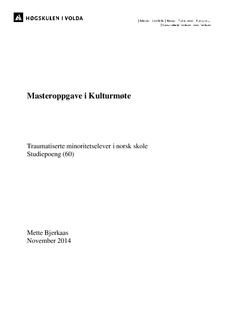| dc.description.abstract | Summary
The aim of this study is to examine how traumatized minority students are received in Norwegian schools. How can we identify these students? What is being done to help them? The study has used the triangulation method. The purpose of using a quantitative research method and a survey to collect the data in the preliminary phase of this project, was to uncover the formal procedures schools follow to identify and deal with traumatized students in general, and specifically traumatized minority students. The survey has been sent to all junior high schools in Oslo. The representatives have answered questions about how the students are identified, and about the measures taken. In the survey I have asked factual and behavioral questions. Taking into account the discoveries I made in the survey, the study also makes use of a qualitative research method. To gather information I interviewed two contact teachers, two social teachers and two contact teachers from a refuge reception center. The informants described their experiences with traumatized students and what the schools do to identify them, as well as which measures they take to deal with this group of students. The interview guide was semi-structured, and with fixed categories that would make sure the answers given would shed light on the topic. Thus, the study’s approach is abductive in its method. Due to practical concerns, the survey was limited to junior high schools in Oslo. I have used univariate and bivariate correlation analysis in the study of the quantitative data to give answers to the thesis question. The univariate analysis gave a clear picture of the phenomena the study examined. The bivariate correlation analysis has sought the connection between one’s role in the school system and one’s previous experiences with traumatized minority students. Through analyzing the qualitative material, I have tried to find the informants’ descriptions of their experiences that would be most relevant to my thesis. Because of this the approach is based in phenomenology. The analysis is divided into topics, with emphasis on differences and similarities in the informants’ statements. This has been done because their experiences and thoughts are subjective and unique, and because schools’ routines might differ from one another. The results of the study show that screenings are not being used as a tool to identify traumas amongst students in general and particularly amongst minority students. The data also shows that when traumatized students are identified, efforts are made mainly by nurses and social teachers, who are specialists connected to the schools. The study shows that it can take a very long time (months or even years) before a traumatized minority student is identified. The results of the research interviews show that there is no system for identifying these students at the schools I have based my research on. This is something that may apply to most Norwegian schools. Further, there is a clear tendency that schools have few formalized relief measures when they identify and deal with traumatized minority students. However, the schools often meet this challenge with a variety of informal measures such as conversations and by making other adjustments that mainly has an academic focus. In sum, both from the quantitative and qualitative material, which are based on a selection of Norwegian schools, it can be concluded that the schools lack a system to identify and help traumatized minority students. | nb_NO |
